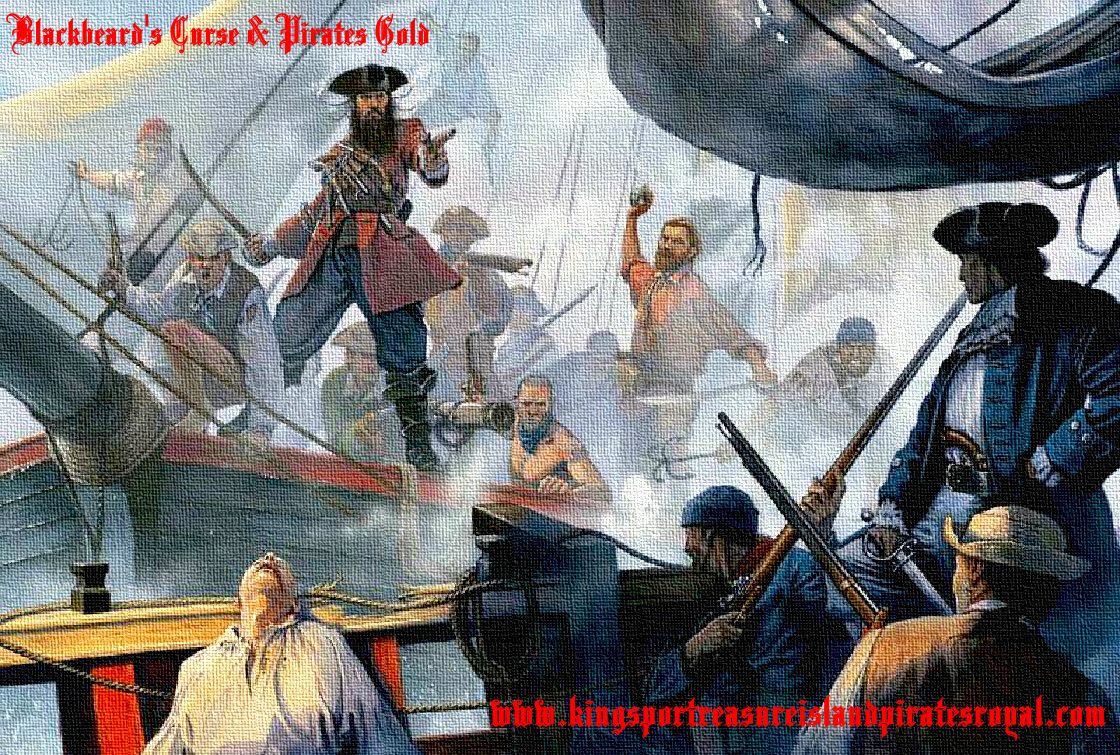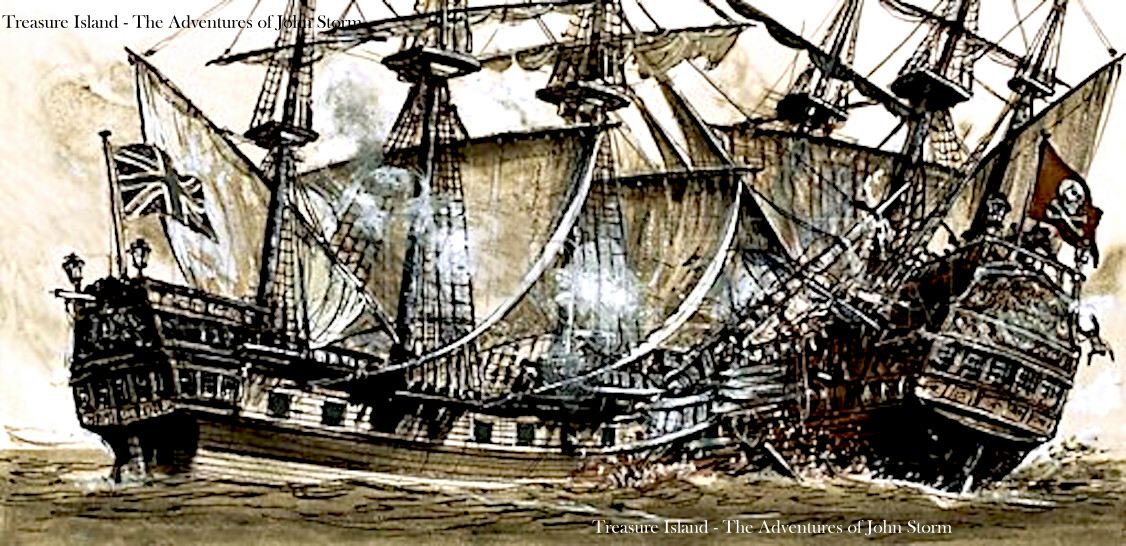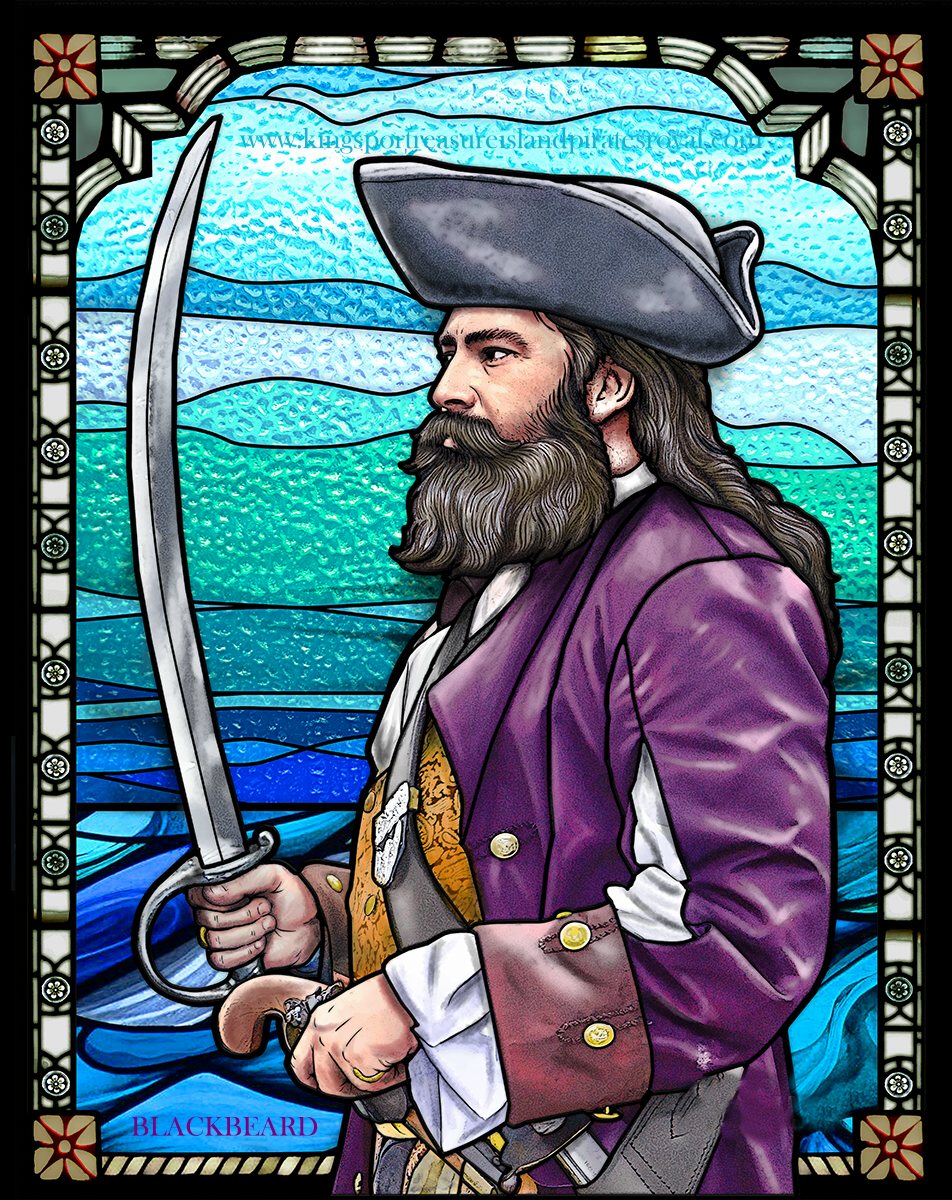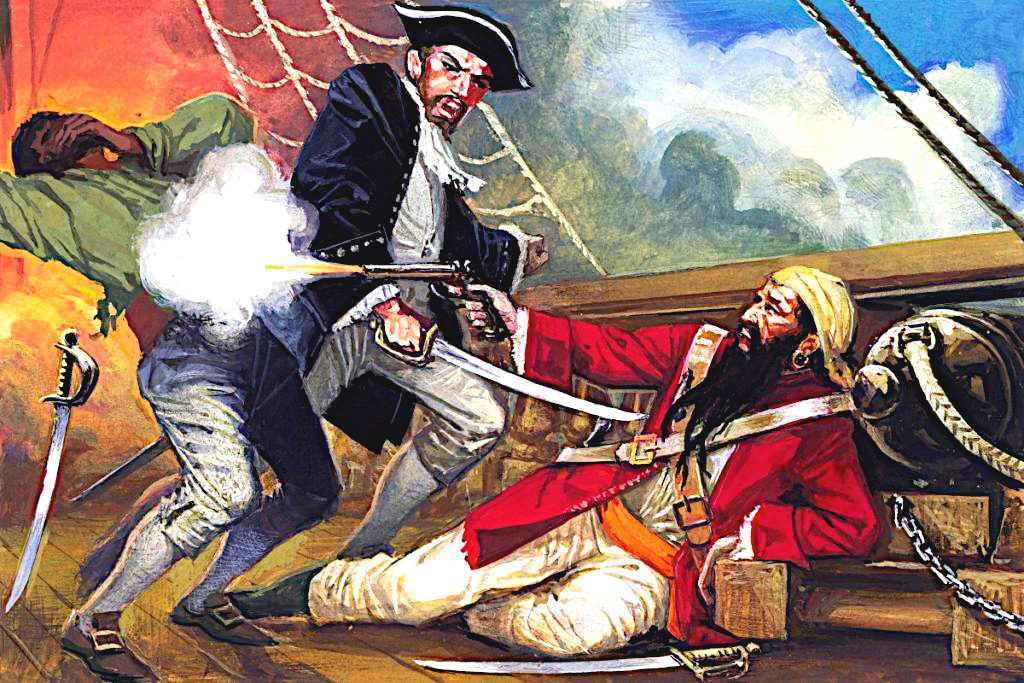|

Lieutenant
Robert Maynard rams the Adventure with his Royal Navy sloop. Then boards
Blackbeard's ship.
THE
BATTLE OF OCRACOKE
It began within minutes after the notorious pirate
Blackbeard was killed in
the Battle at Ocracoke on Saturday morning, November 22nd 1718.
As soon as the wounded were attended to and the surviving pirates were placed under guard, the hunt was on, led by Royal Navy
Lieutenant Robert
Maynard. The first place they searched was Blackbeard’s cabin in the roundhouse of his 65-foot-long Jamaica-rigged sloop, Adventure. Surely the world’s best-known and most-feared pirate captain kept a chest of Spanish
gold,
silver and
jewels hidden beneath his bunk, just for his
walkin’ around money.
Rarely mentioned in the many books, articles and other accounts of the famous battle is that Maynard and the other volunteer sailors from the British king’s ships stationed in Virginia were persuaded to accept the potentially deadly assignment of apprehending or killing the North Carolina pirates by the prospect of acquiring pirate treasure. It could be said that the 60 men aboard the two, small, rented sloops under Maynard’s command were little more than pirates themselves.
Two weeks after the smoke cleared from the battle, Maynard and his men were still hoping to find a treasure on Ocracoke Island that would make them all rich. They were disappointed. In addition to casks of sugar, cocoa, indigo dye and a few bales of cotton, only a small amount of what is called gold dust, small nuggets of gold, were recovered from the pirates’ possessions.
Maynard’s stay at Ocracoke may have been when an enduring Blackbeard
myth was born. While nine captive pirates were held in the lower deck of the Adventure while anchored in the yet-to-be-named Teach’s Hole Channel, a guard may have asked them,
so, where did the boss hide his treasure? Funny you should ask, a pirate replied, we posed that question to him just last night.
The published version of the interrogation in a 1724 book, ”A General History of Pirates,” goes like this: “… one of his Men asked him, in Case any thing should happen to him in the Engagement with the Sloops, whether his Wife knew where he had buried his Money? He answered, That no Body but himself and the Devil, knew where it was, and the longest Liver should take it all.”
Among the many dubious aspects of the preceding quote, my research has proven that Blackbeard and his men had no idea on the night before the battle that they were under any threat at all. Having arrived from the inland waters of the colony and anchored alongside Beacon Island 3 miles away from the pirates’ moorings near today’s Springer’s Point, Maynard’s sloops had all the appearances of typical merchant vessels preparing to put to sea.
Nevertheless, ever since, writers and historians have assumed that because the quote was in print – like so many other popular but improbable Blackbeard legends – it must have been true.
At the end of the two weeks at Ocracoke, Maynard sailed Blackbeard’s Adventure across Pamlico Sound and up to Bath, but not with the pirate’s head hanging under the bowsprit as is so often told – it was too valuable, worth a bounty of 100 pounds sterling back in Virginia. In Maynard’s wake, however, has streamed, like the gold of marine phosphorescence, the hopes of the credulous that Blackbeard’s lost treasure might still be found.

Lieutenant
Robert Maynard rams the Adventure with his Royal Navy sloop. Then boards
Blackbeard's ship.
ABOUT
ROBERT MAYNARD
Lieutenant
Robert Maynard is famous for his swordplay with Blackbeard aboard the
'Adventure' in 1718, off Charlestown, North Carolina, having cornered the
former Caribbean
privateer.
Before
dispatching Edward
Teach, by beheading the pirate, Lt. Maynard and his crew, inflicted a
claimed 20 cuts with their blades, each time trying to get the pirate to tell
where he'd hidden his hoard of treasure. For it did not appear to be on
board his ship. Blackbeard
was also shot five times during the encounter. He just would not die easily.
But expire he did, and with his dying breath he cursed Maynard, his crew and
their ancestors after them, should they search for, or locate, his stash.
Robert Maynard
was a British lieutenant, and later captain, in the Royal Navy. Little is known about Maynard's early life, other than he was born in England in 1684 and then later joined the English Navy. He was made a lieutenant in January 1707, and by 1709 was the third lieutenant on HMS Bedford. Maynard was born in Dartford, Kent, England on 19 September
1684 He died on 4th January 1751.
In November 1718, Maynard was tasked with hunting down and killing the notorious pirate Blackbeard. While leading HMS Pearl, Maynard lured Blackbeard into attacking his ship off the coast of North Carolina, and in the ensuing struggle Maynard and his crew killed Blackbeard. Expecting to be rewarded for his actions, Maynard was never fully compensated or paid for the expedition. He was eventually promoted to commander in 1739, and to captain in 1740, before dying at the age of 66 in his home county of Kent,
England.
Maynard"s final resting place is in the churchyard of Great Mongeham in Kent,
south-east England, near the cinque port of Deal He left an estate in excess of £2000. Maynard"s success is still celebrated by his successors — the crew of the current HMS Ranger — who commemorate Blackbeard"s defeat at the annual
Sussex University Royal Naval Unit Blackbeard Night mess dinner every year, at a date as close as possible to 22 November.
Maynard's success is still celebrated by his successor – the crew of the current HMS Ranger – who commemorate Blackbeard's defeat at the annual Sussex University
Royal Naval Unit Blackbeard Night mess dinner every year, at a date as close as possible to 22 November.
The City of Hampton, Virginia also celebrates its historic ties to Maynard by recreating the final sea battle on Tall Ships in the Hampton Harbour during the city's annual Blackbeard Festival in June.

BLACKBEARD
MAN & MYTH
For
sure, if you’ve ever heard a pirate story, you will have heard of Blackbeard.
That name alone probably conjures up a specific image: something woodcut, ferocious and timeworn. Blackbeard, depicted onboard a ship, or with the sea just behind him – complete with a cutlass in hand, his signature long, dark beard and a defiant glare.
You also probably know Blackbeard’s story specifically – or at least some version of it. One of (if not the) most fearsome pirates of all time, he amassed gold (and, reportedly, wives) with impunity in the
Caribbean
Sea and along the shores of colonial North America during the 18th century, until he was beheaded by British naval forces in the Pamlico Sound near Ocracoke Island – leaving behind an enormous treasure that’s still mysteriously missing.
It’s a compelling account for many reasons, not least of all because it smacks of daredevil adventures on the high seas mixed with a dash of romance and plenty of intrigue. But perhaps the most interesting thing about Blackbeard and these types of enduring narratives – which appear to be more fictional than anything else – is that they’ve inspired a public fascination with him that’s been ongoing for 300 years now.

THE MAN
While there’s no doubt that a person known as Blackbeard actually existed, many people are surprised to learn that the verifiable facts about him and his exploits during what’s now known as
the Golden Age of Piracy barely amount to more than a historical footnote.
Over the years, various scholars and other writers (many of whom were decidedly inclined to take creative liberties in place of known facts), have suggested that Blackbeard hailed from places as far-flung as England,
Jamaica and Philadelphia – but the truth is that there’s no conclusive evidence to support any of those theories.
Disney's
Pirates
of the Caribbean movie, is one such example of expanding the myth, and
very entertaining is was.
Not only are his origins obscure, but even his supposed original name is dubious at best. Though numerous present-day accounts insist that he was known as Edward Teach before his reputation earned him the moniker “Blackbeard,” his first historically documented appearance is as Edward “Thatch” in 1716.
Bearing in mind that standardized spelling was virtually nonexistent at the time (Samuel Johnson’s A Dictionary of the English Language, the first widely accepted dictionary, wasn’t published until almost four decades later in 1755), it should come as no surprise that several other forms of that surname (including “Tach” and “Thache”) exist – and many people have since suggested that all of those variations could have simply been other aliases anyway.
And as for Blackbeard’s bloodthirsty reign of terror? Truth be told, the historical records only support the fact that his piratical career lasted less than two years (from late 1716 until his death on November 22, 1718) – and there is absolutely no evidence that he killed, or even harmed, a single person prior to that fateful, final battle on Ocracoke.
THE MYTH
The stories about Blackbeard are legion. From books to movies, his life has been immortalized in a countless number of ways. But while it may be tempting to chalk that up entirely to modern-day amusements, the fact of the matter is that Blackbeard was already in the process of being mythologized during his lifetime.
Some of this can almost undoubtedly be attributed to the Boston News-Letter. Though the News-Letter wasn’t the first newspaper printed in the North American colonies, it does have the distinction of being the first continuously published American newspaper.
Albeit with a limited circulation, the News-Letter was printed on a weekly basis from 1704 to 1776, and it was one of the very first publications to make Blackbeard’s name headline news – particularly after publishing an account of his sensational death at the hands of British forces led by Lieutenant Robert Maynard.
Then, just as now, a thrilling story of piratical battles was enough to spark people’s imaginations – enough so that even a then-teenaged Benjamin Franklin subsequently penned a ballad about Blackbeard’s downfall to (profitably) sell on the streets of Boston.
And that’s only the tip of the iceberg in terms of the stories that have accumulated (for monetary reasons and otherwise) around Blackbeard over the years – particularly on the Outer Banks. Ask nearly anyone who’s lived in this area long enough, and you’ll hear tales that Blackbeard’s headless corpse inexplicably swam around Maynard’s ship three to seven times before it sank, and more than a few locals will swear to having seen a ghostly light lingering on the waters off of Ocracoke (which is said to be Blackbeard’s soul restlessly searching for either his treasure or his head
[Sleepy Hollow] – take your pick).
As for that treasure: Whether it’s ultimately real or imagined, there’s no record that anything remotely matching that description has ever been found. According to some of the lore, that’s because Blackbeard made a pact with the Devil stating that only the two of them would know where it was hidden – and only the one who lived the longest could claim it as his due prize.
40 GUN FLAGSHIP - 1996
Just when we all thought we should be able to close the case on Blackbeard, another chapter
shines forth. In 1996, a private salvage company based out of Florida discovered a shipwreck in the waters near present-day Beaufort, North Carolina.
Almost from the start, there was speculation that it could be Blackbeard’s short-lived, 40-gun flagship, the Queen Anne’s Revenge (which he reportedly sailed for less than a year before he ran it aground in June of 1718, six months before his death on Ocracoke).
Although divers from the North Carolina Department of Natural and Cultural Resources (NCDNCR) began excavating the wreck in 1998, and the site was placed on the U.S. National Register of Historic Places in 2004, it wasn’t officially authenticated as Blackbeard’s Queen Anne until 2011.
So far, hundreds of thousands of artifacts have been recovered from the Queen Anne, including apothecary weights, a copper-alloy sword guard, small amounts of gold mixed with lead shot, medical syringes, cannons and one of the ship’s nearly 3,000-pound anchors.
To this day, joint research and further conservation efforts are still ongoing under the direction of the
NCDNCR. 2018 marks the 300th anniversary of both Blackbeard and the Queen Anne’s
demise.
If
you agree that to be a less-than-satisfactory
conclusion, consider the fictional John
Storm adventure, that sheds new light on the motives of all those
concerned. This opens up new avenues of thought, such that the Blackbeard
story, both myth and man, can’t ever truly be closed.

NAVAL COMMANDS AND BATTLES
Governor Alexander Spotswood of the Colony of Virginia gave Maynard the command of two sloops, Ranger and Jane. They departed the docks of Hampton, Virginia on 19 November 1718. Maynard caught up with Blackbeard at
Ocracoke Inlet off the coast of North Carolina on 22 November 1718. Most of Blackbeard's men were ashore, whilst Maynard out-gunned and out-numbered the pirates three to one. However, Maynard's ship had no cannons and only small-arms, while Blackbeard's had up to eight cannons, though Maynard hid most of his men below deck. Initially, Blackbeard had his ship go to shallower water. Maynard's heavier ship hit a sand-bar and was stuck. Blackbeard then manoeuvred his ship to fire a broadside at Maynard's ship. Meanwhile, Maynard, who was on the sloop Jane, ordered everything inessential to combat to be thrown overboard to make the ship lighter, and eventually freed the ship. Blackbeard's ship fired at least two more broadsides on Maynard's, killing several of Maynard's men.
After the last attack, it appeared to the attackers that only Maynard and another crew member were left alive and Blackbeard and some of his men boarded Maynard's ship. He was then ambushed by a force much larger than he had expected; Maynard had told his surviving soldiers to hide below deck only to come out and attack at a given signal. During the battle, Maynard and Blackbeard ended up in hand-to-hand combat. Both pointed pistols at each other. Maynard shot his adversary at point-blank range, while Blackbeard missed. However the shot failed to stop his opponent. Blackbeard pressed on, breaking Maynard's sword. Finally, another sailor jumped on Blackbeard's back and inflicted a deep wound. Maynard was then able to kill Blackbeard.
Maynard later examined Teach's body, noting that it had been shot no fewer than five times and cut about twenty. He also found several items of correspondence, including a letter to Teach from Tobias Knight, the Royal Secretary for North Carolina. Blackbeard was decapitated and his head was tied to the bowsprit of his ship for the trip back to Virginia. Upon returning to his home port of Hampton, the head was placed on a stake near the mouth of the Hampton River as a warning to other pirates.
Lieutenant Maynard remained at Ocracoke for several more days, making repairs and burying the dead. Teach's loot – sugar, cocoa, indigo and cotton – found "in pirate sloops and ashore in a tent where the sloops lay", was sold at auction along with sugar and cotton found in Tobias Knight's barn, for £2,238.
Governor Spotswood used a portion of this to pay for the entire operation. The prize money for capturing Teach was to have been about £400, but it was split between the crews of HMS Lyme and HMS Pearl. As Captain Brand and his troops had not been the ones fighting for their lives, Maynard thought this extremely unfair. It was later discovered that he and his crew had helped themselves to about £90 of Teach's booty. The two companies did not receive their prize money for another four years, and despite his bravery, Maynard was not promoted, rather, he faded into obscurity.

Aboard
the Adventure in 1718, Lieutenant Robert Maynard shoots and kills Blackbeard
It
is said that "Dead Men Tell No Tales." For the most part that is
true, but some men leave clues as to their exploits when they are alive. And
those clues are tales from a dead man. Two such people are Captain
Henry Morgan and Edward
Teach, otherwise known as Blackbeard.
|


